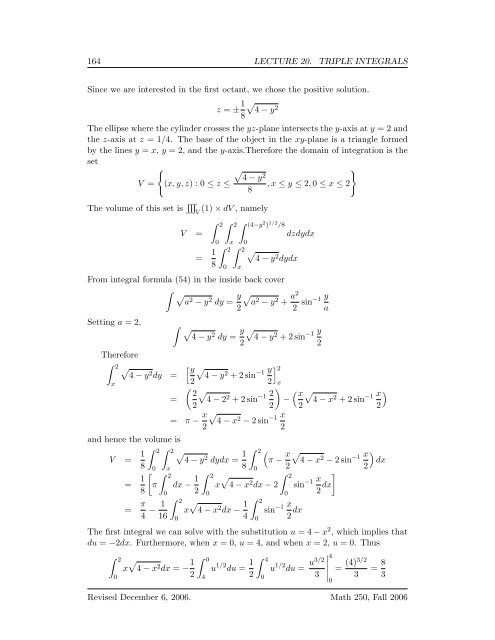Multivariate Calculus - Bruce E. Shapiro
Multivariate Calculus - Bruce E. Shapiro
Multivariate Calculus - Bruce E. Shapiro
You also want an ePaper? Increase the reach of your titles
YUMPU automatically turns print PDFs into web optimized ePapers that Google loves.
164 LECTURE 20. TRIPLE INTEGRALS<br />
Since we are interested in the first octant, we chose the positive solution.<br />
z = ± 1 8√<br />
4 − y 2<br />
The ellipse where the cylinder crosses the yz-plane intersects the y-axis at y = 2 and<br />
the z-axis at z = 1/4. The base of the object in the xy-plane is a triangle formed<br />
by the lines y = x, y = 2, and the y-axis.Therefore the domain of integration is the<br />
set<br />
{<br />
√ }<br />
4 − y 2<br />
V = (x, y, z) : 0 ≤ z ≤ , x ≤ y ≤ 2, 0 ≤ x ≤ 2<br />
8<br />
The volume of this set is ∭ V<br />
(1) × dV , namely<br />
V =<br />
= 1 8<br />
∫ 2 ∫ 2 ∫ (4−y 2 ) 1/2 /8<br />
0 x 0<br />
∫ 2 ∫ 2<br />
0<br />
x<br />
√<br />
4 − y 2 dydx<br />
dzdydx<br />
From integral formula (54) in the inside back cover<br />
∫ √a 2 − y 2 dy = y 2√<br />
a 2 − y 2 + a2<br />
2 sin−1 y a<br />
Setting a = 2, ∫ √4<br />
− y 2 dy = y 2<br />
√<br />
4 − y 2 + 2 sin −1 y 2<br />
Therefore<br />
∫ 2 √<br />
4 − y 2 dy =<br />
[ y √<br />
4 − y<br />
2<br />
2 + 2 sin −1 y 2<br />
x<br />
=<br />
( 2 √<br />
4 − 2<br />
2<br />
2 + 2 sin −1 2 2<br />
] 2<br />
x<br />
) ( x √<br />
− 4 − x<br />
2<br />
2 + 2 sin −1 x )<br />
2<br />
= π − x 2<br />
√<br />
4 − x 2 − 2 sin −1 x 2<br />
and hence the volume is<br />
V = 1 ∫ 2 ∫ 2 √<br />
4 − y<br />
8<br />
2 dydx = 1 ∫ 2 (<br />
π − x √<br />
4 − x<br />
0 x<br />
8 0 2<br />
2 − 2 sin −1 x )<br />
dx<br />
2<br />
= 1 [ ∫ 2<br />
π dx − 1 ∫ 2<br />
x √ ∫ 2<br />
4 − x<br />
8<br />
2<br />
2 dx − 2 sin −1 x ]<br />
2 dx<br />
= π 4 − 1 16<br />
0<br />
∫ 2<br />
0<br />
0<br />
x √ 4 − x 2 dx − 1 4<br />
∫ 2<br />
0<br />
0<br />
sin −1 x 2 dx<br />
The first integral we can solve with the substitution u = 4 − x 2 , which implies that<br />
du = −2dx. Furthermore, when x = 0, u = 4, and when x = 2, u = 0. Thus<br />
∫ 2<br />
x √ 4 − x 2 dx = − 1 ∫ 0<br />
u 1/2 du = 1 ∫ 4<br />
4<br />
u 1/2 du = u3/2<br />
= (4)3/2<br />
= 8 2<br />
2<br />
3 ∣ 3 3<br />
0<br />
4<br />
Revised December 6, 2006. Math 250, Fall 2006<br />
0<br />
0
















